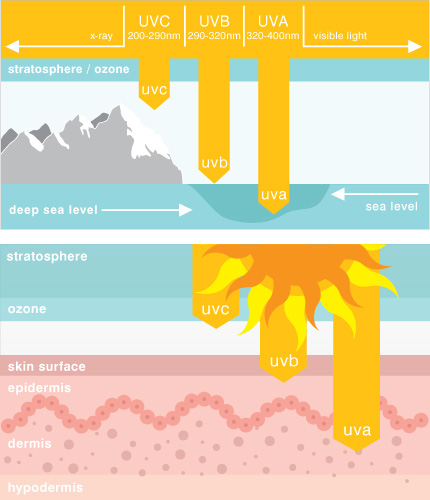Sunscreen Simplified!
April 29, 2013 4:20 pmTrying to buy sunscreen can be a confusing and overwhelming numbers game: 10, 15, 32, 45, 51, 100! The FDA’s rules for what concretely defines “sun screen” seemingly changes from year to year and their regulations and verbiage really don’t make it any easier. As a skincare professional, sun protection is something I stress to all of my clients and so before the brilliance of Summer is upon us I thought we’d take a look at what we know about sun protection, what those random numbers mean, how the sun’s rays interact with the skin, and how to best choose a sunscreen that’s right for you
UV, the Broad Spectrum, and SPF
UV stands for ultraviolet: UV-A and UV-B rays are the two main types of sun exposure that we need to worry about (there is also a UV-C ray, but they have trouble getting through the earth’s atmosphere, so exposure is fairly minimal). UV-A rays contribute to premature aging while UV-B rays, on the positive side, help our bodies create the much needed Vitamin B and on the negative side, contribute to burning. All UV rays contribute with varying degrees to skin cancer.
SPF stands for “sun protection factor”. This is a basically a way to determine the length of time you can stay out in the sun without burning. The SPF number only relates to the more potent UV-B. U-VA protection is not measured through these numbers, and until recently, not available in sunscreens.
When you see the words broad spectrum on a tube of sunscreen, this means that the sunscreen will help protect your skin from both UV-A and UV-B rays. Most sunscreens only protect against UV-B rays to prevent burning, but now many companies are realizing the importance of including UV-A protection and labeling their products “broad spectrum” to match the amount of protection.
Now that you’re up to speed on the basics, we come to a fairly simple equation that will help you determine what SPF would be best for you, but first you’ll need to know how long you can be in the sun WITHOUT sunscreen before you burn. If your length of sun exposure before burning is, let’s say 10 minutes, and you’ve bought an SPF 15, you can be out in the sun wearing SPF 15 for 150 minutes before you will burn (keeping in mind you need to reapply your sunscreen every 2 hours or so). This number alone doesn’t give you the full picture of protection, which can lead to the thinking that you are more protected than you actually are. If you’re sweating, swimming, or have clothing rubbing against your skin, you can wear your sunscreen off sooner. When in doubt, reapply! Also it’s best to avoid the sun between 10 am and 2 pm, when UV-B rays are strongest.
Is Sunscreen Really Waterproof?
I get this question daily (I’m not kidding). Nothing that you squeeze out of a bottle or spray onto your skin is 100% waterproof. Even if it says “water-resistant” or “sweat-proof”, it’s still just Madison Avenue marketing speak. Re-application of sunscreen is VITAL. If you don’t rub your skin while swimming you’ll stay protected in the water for 40-60 minutes. But you must reapply after getting wet, sweating, and especially toweling off.
“I have ethnic skin and never sunburn. Do I still have to wear SPF?”
YES! Your skin contains more pigment than people with fair skin, and you still need to wear sunscreen every day! Even if you can’t see any sunburn, the sun is still inflicting damage on your skin in the form of skin cancer and wrinkles. Wear sunscreen!
What Sunscreen Do You Recommend?
I look for anything containing zinc oxide and/or titanium dioxide as the active ingredient(s). These are known to skincare professionals as “physical sunscreens”, as they are not absorbed into your skin – they simply sit on top and act as a barrier, reflecting the sun’s rays away from the skin. Additionally, physical sunscreens won’t irritate the skin, as they aren’t absorbed and are made of natural ingredients. In the past, physical sunscreens were very thick and would leave a white film on the skin – now, the ingredients have been “micronized” to be more esthetically pleasing while still providing the best sun protection.
At 360 Skin we carry Image’s Matte Moisturizer SPF 32. This is an oil-free, broad spectrum UV-A/UV-B moisturizer which absorbs the skin’s surface oils leaving it with a matte, non-greasy, shine-free finish. This sunscreen also contains the potent antioxidant thiotaine that helps protect your skin from free radical damage.
And Finally
Make sure you and your family stay protected whenever you’re heading outside. Check your sunscreens for the words “broad spectrum” and always choose an SPF over 15 that lists titanium and zinc oxide as the active ingredients. To apply, make sure you use enough product EVERYWHERE! It generally takes a golf-ball sized dollop of sunscreen to cover an adult’s entire body. Don’t forget your hands, feet, and chest. And finally…get outside, enjoy the beautiful weather, and have a GREAT summer!



Great posting! I had no idea how little I knew about sunscreen. And since I am very fair skinned, sunscreen is something I need to understand. Thanks 360 Skin!